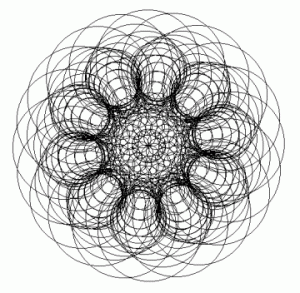Chapter 2.5 Magnetic Field and Gravitational Field.
It should be now clear that they are the same thing. Once shown in chapter I that the the gravitational field is a dipole, it is self-evident the magnetic field is a highly polarized gravitational field, with a consequent strong interactivity toward bodies, particles and materials having a deeply complementary structure.
Although it is not possible to provide with details during this brief introduction to the matter, it is already clearly understandable. The more the polarization is higher, the more it brings to a greater concordance of axes and planes of propagation, with an increase of coincidences of “lines of force” – especially at the poles and along the axis – with progressive intensification of effects.
The macrocosm has a large dispersion of the axes of polarization, which led to hide to the eyes of the scientists a substantially generic dipolarity of gravitation, and this is due to the greater disorder of the material aggregation compared to the atomic structures.
On the contrary, the phenomenon of dipole is dominant among the atomic-nuclear structures, and, together with the high density of each particle, is the factor exponential multiplier of the force of gravity in the subatomic world: a factor that, lacking entirely in the Newtonian formulation, where only the masses are considered, has led physicists to believe to a weak microcosm gravitation. That same density not affecting the Newtonian calculation for an isotropic gravity becomes a key factor in the exponential increase of force, if combined with the effect of polarization. A quick calculation of the density (mass / volume) of the proton gives a value of over 3 million billion times the density of water.
Differences in the microcosm of interactivity – such as between photon and neutrin, proton and neutron, etc. must be traced back to situations of varying degrees of magnetic orientation of particles, such as in the macrocosm of magnetized substances differently.
The polarization of a field is genetically related to its rotation (see chapter I: the problem will be resumed when we’ll describe geometrically and functionally the field). Between the South Pole of a magnetized bar and the North of another one, axially disposed with the first, the rotation of the field is accordant. The innumerable particles orbiting in the space between the axis of a magnet the other one proceed in the same direction, then at very low relative velocities: for the same reason explained in the previous chapter they attract each other, dragging the two bars in the motion of approach.
The effect is the opposite when putting closer two similar poles: the rotation of the field is discordant. The particles in transit between the two fields orbit in opposite directions, that of a field to the other, and consequently have reciprocal fast speeds, leading to the phenomena of escape. The two bars appear to repel each other. If you look closely at the phenomenon, you will see that the “repulsion” is not manifested as a movement in opposite directions along a straight line, but it has a rotational pattern, which is typical of gravitational events of tangential escape.
The difference between gravitational force and other forces therefore falls: the distinction between the magnetic field and gravitational field and the thesis that gravitation would be prevalent in the macrocosm and microcosm in almost non-existent, while the opposite is true for electro-nuclear forces.



